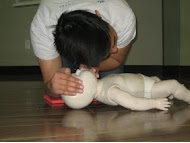
follow during Infant CPR
CPR is an abbreviation for cardiopulmonary resuscitation, and is a procedure that is performed when someone’s heartbeat or breathing has stopped. There are a number of reasons why this may happen, but the similarity between them is that both will involve two facets of CPR which are:
- Rescue breathing whose sole purpose is to ensure that the lungs get adequate oxygen
- Chest compressions which are done to make sure that the blood continues to flow to different parts of the body, and especially the vital organs of the body including the brain. If this does not happen in good time, there is the likelihood that permanent brain damage will occur. As such, infant CPR must be continued until either breathing resumes or medical personnel arrive.
What are some of the reasons why CPR has to be carried out in infants?
- Chocking could cause an infant’s breathing to stop, thus creating the need for CPR
- Trauma to the head as would be the case in accidental falling.
- Poisoning
- Suffocation almost always leads to breathing cessation in infants
- Drowning is also another common cause of an infant’s heartbeat stopping.
If any of these happen, and the infants is unconscious, not breathing and has no pulse, infant CPR is the way to go. Below is a step by step procedure that outlines the first aid approach for infant CPR.
- Check to see whether the infant is alert by stirring them gently. See if they respond in any way.
- If the infant is unresponsive, call for help. Avoid leaving the infant alone until you have performed CPR for 2 minutes.
- Place the infant face-up, checking to make sure that there is no spinal injury.
- Start doing the chest compressions by placing two fingers right below the nipples. Take care not to do this at the breastbone as it could cause injuries. Ensure that the infant’s head remains tilted at an angle towards the back. Press down on the chest, until it is halfway through before allowing the chest to come up completely. Take note that these compressions come in fast with no pause.
- Ensure the airway remains open by elevating the infant’s chin with one hand, and with the second, allow the forehead to go down.
- Check to see whether breathing has resumed. If the infant is still not breathing, cover their mouth and nose to create a tight seal using your mouth. With the head bent at an angle, avail 2 rescue breaths, each a second long.
- Carry on with infant CPR for a couple of minutes. Repeat the rescue breaths until the infant’s breathing resumes or until help arrives.
NB: avoid lifting the infant’s chin as you bend their heads as this could cause the tongue to move away from the windpipe with dire consequences. You must also avoid starting on chest compressions if the infant is breathing normally otherwise infant CPR could have the opposite effects, stopping the heartbeat of the patient.
